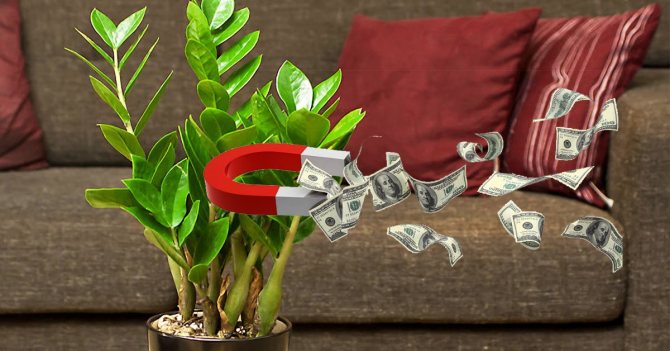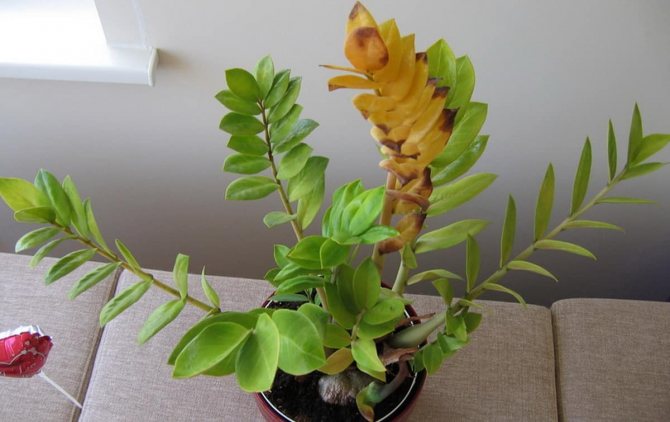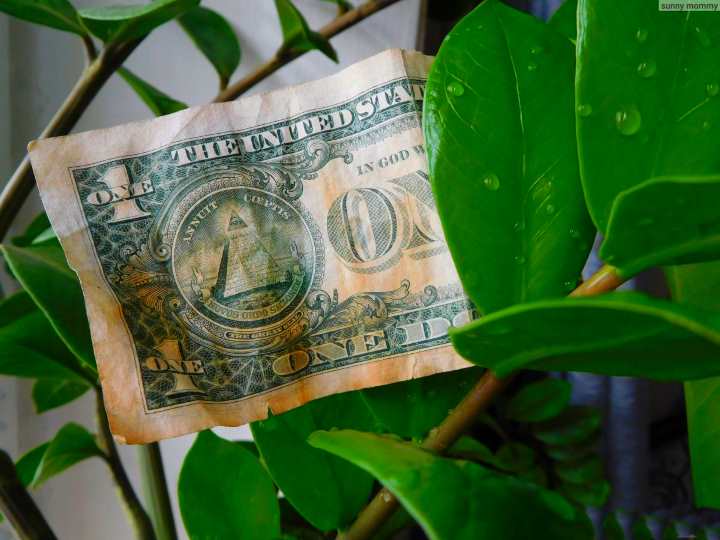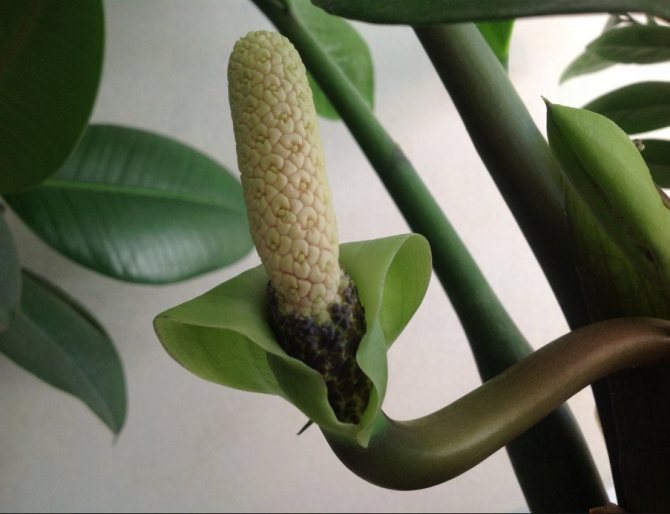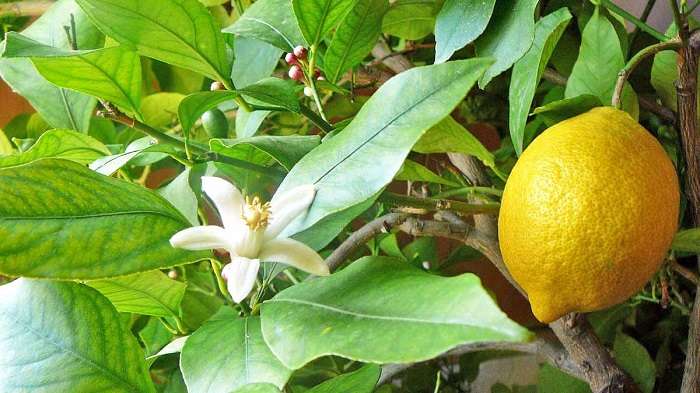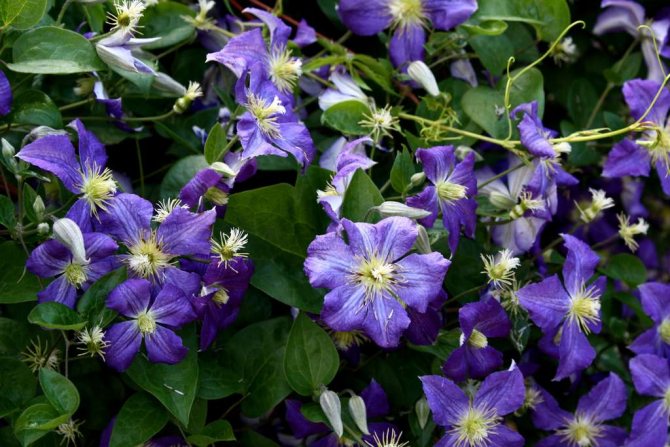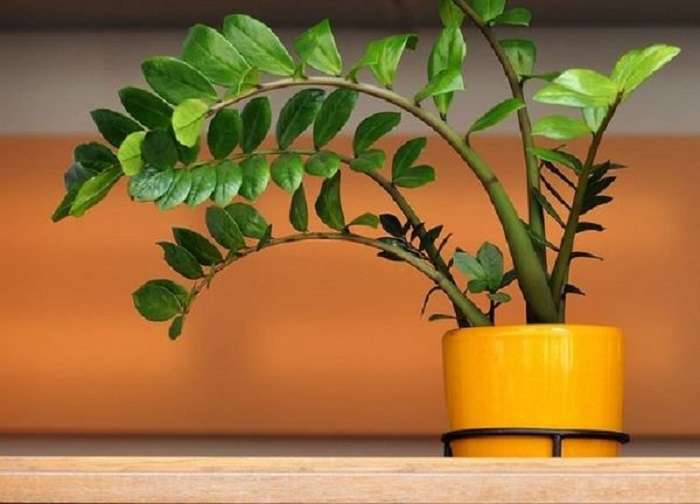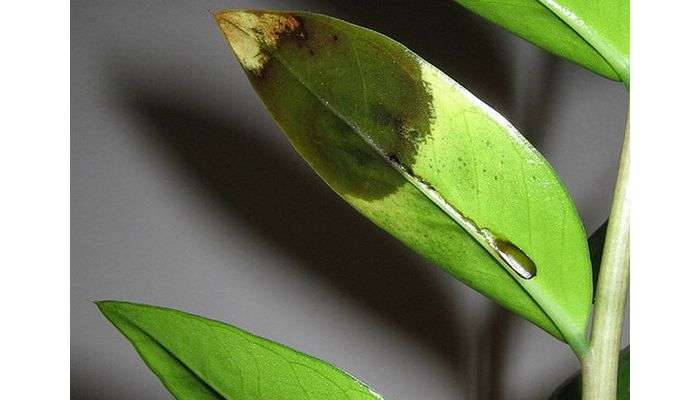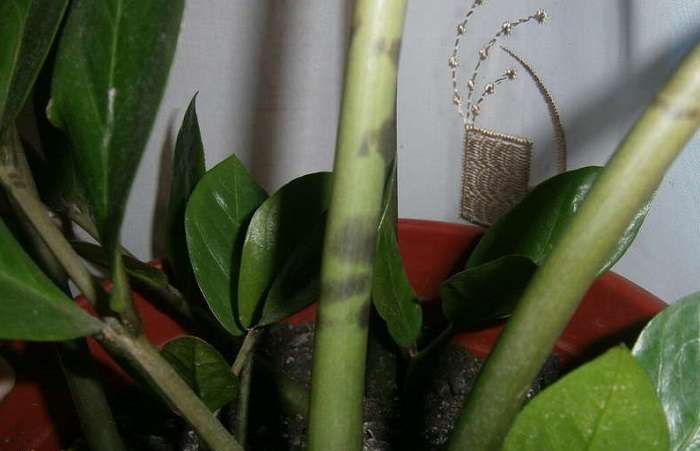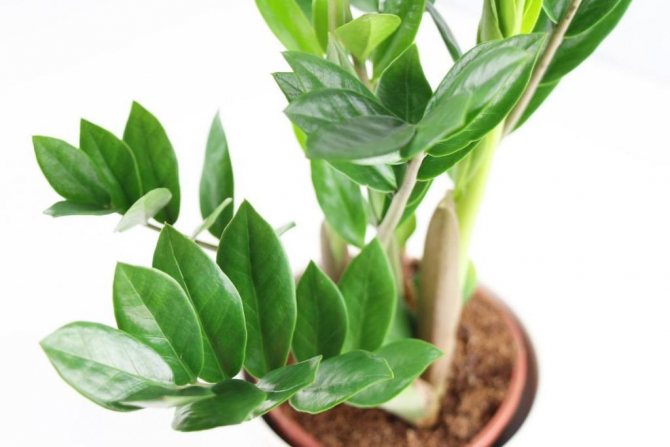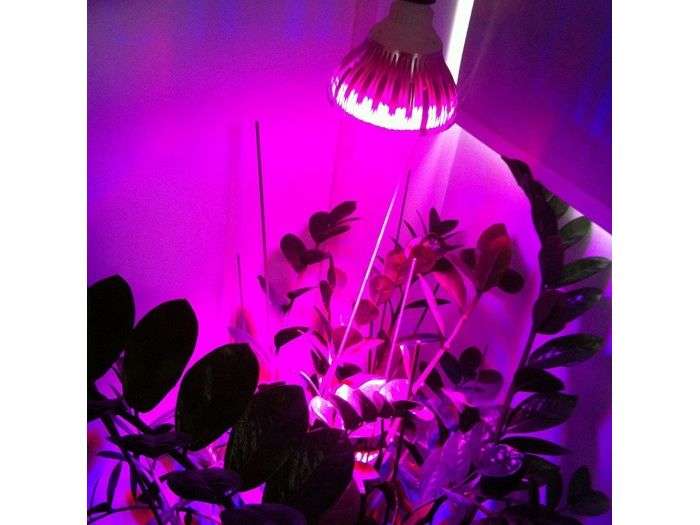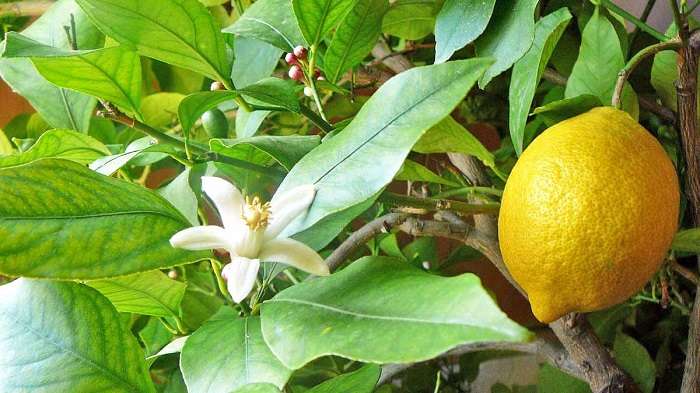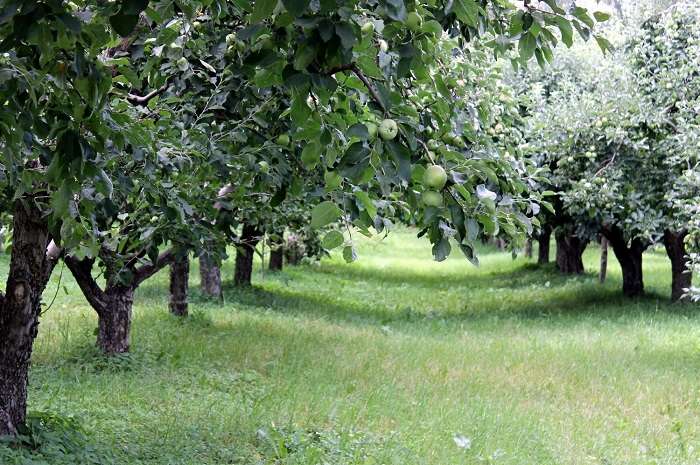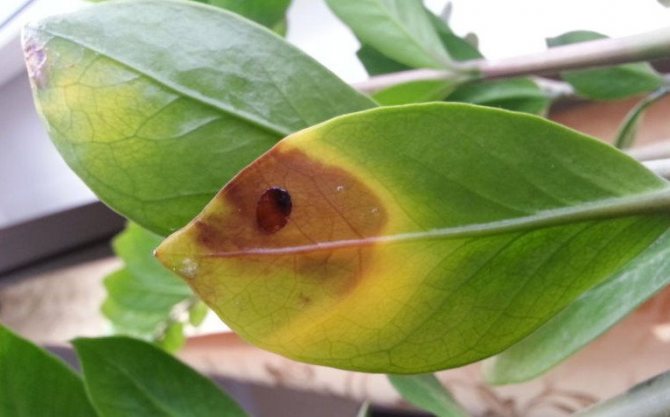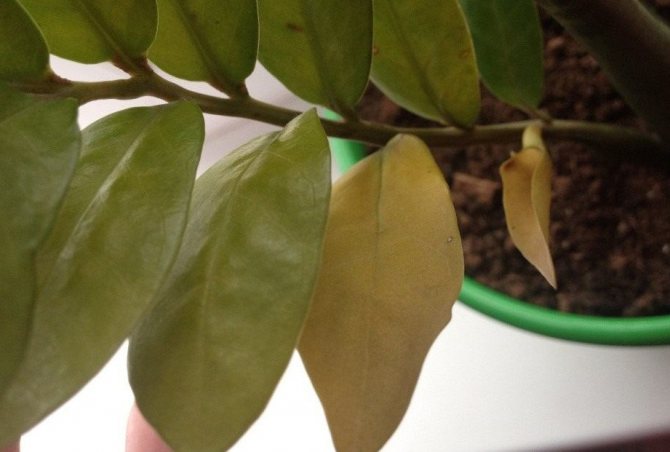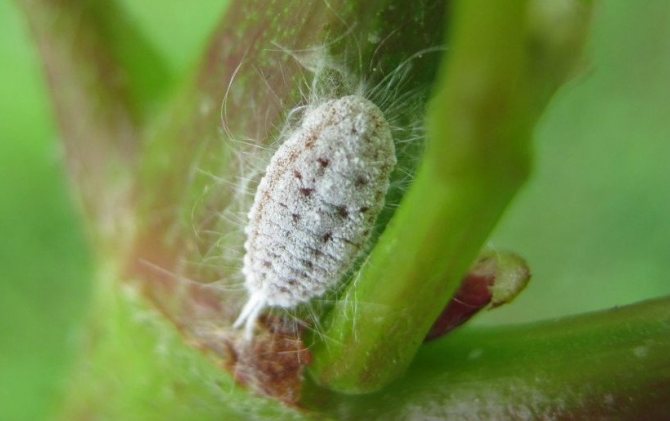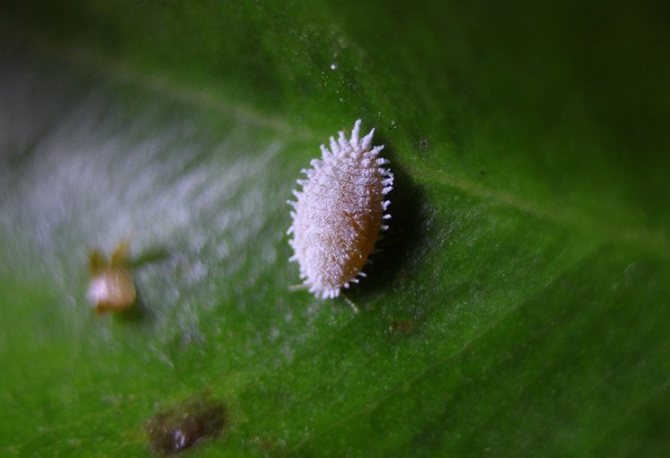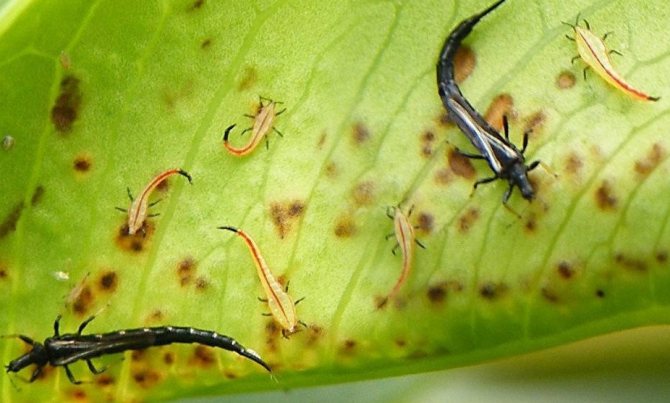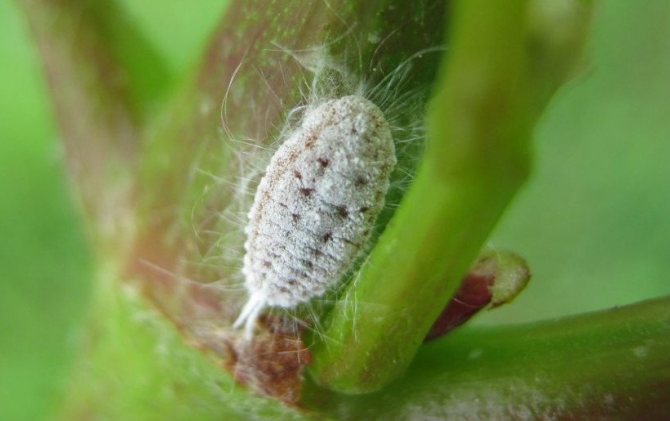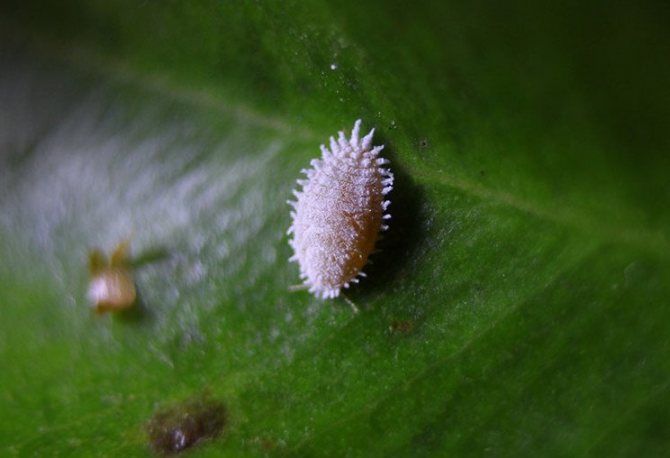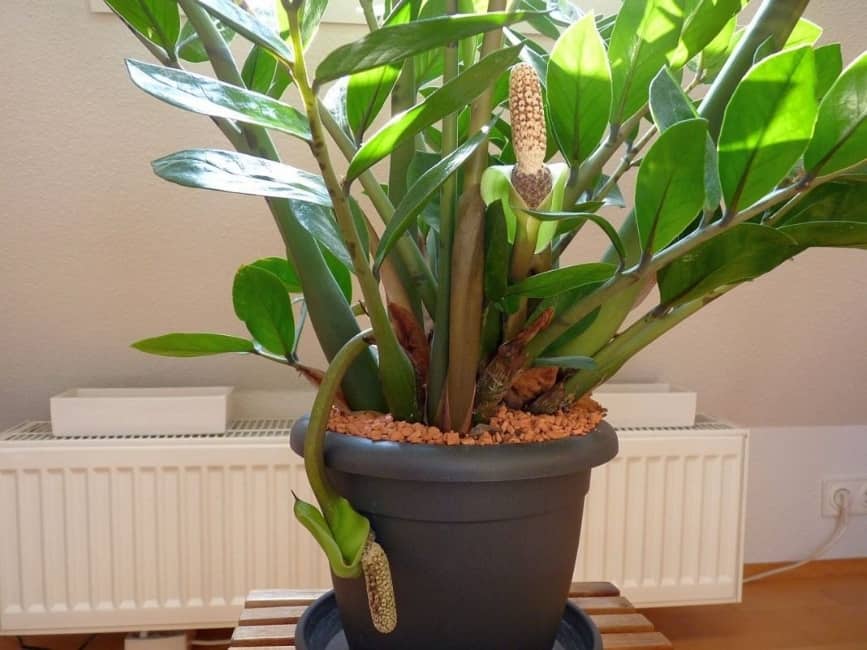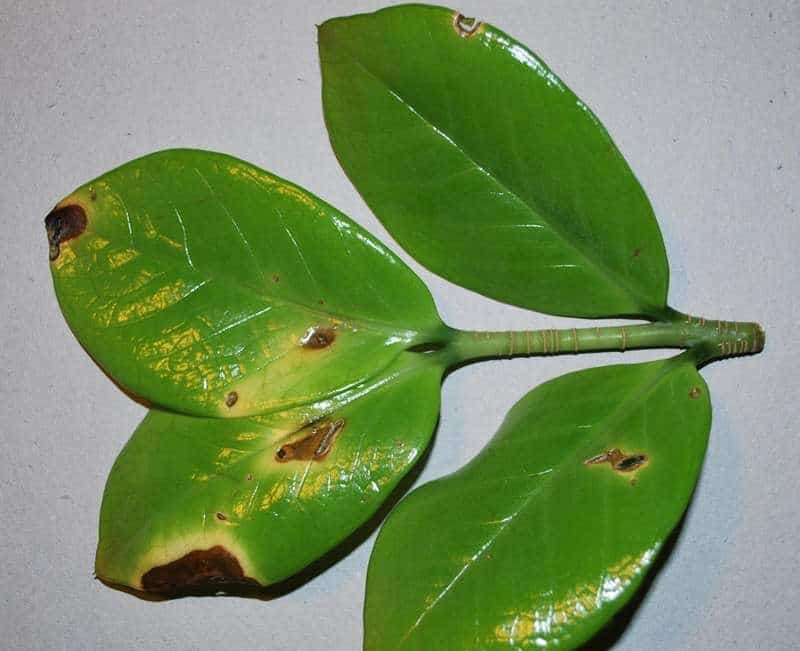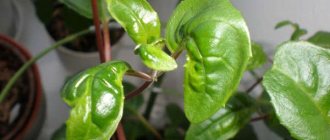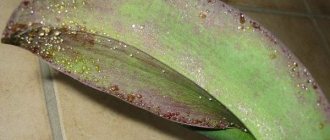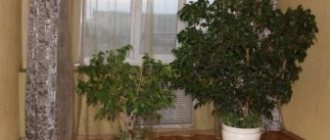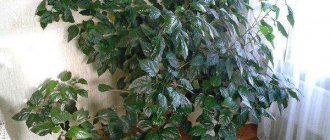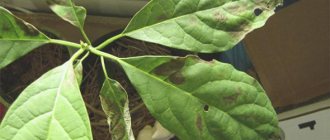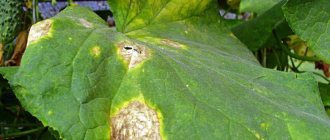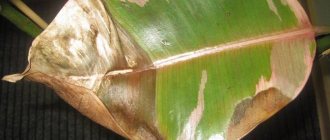Despite its exoticism, zamioculcas took root very well at home. The plant is extremely unpretentious - completely insensitive to dry air and feels great, both in the open sun and in partial shade. The temperature regime of our latitudes is also quite suitable - from 10 ° C to 30 ° C and even higher, the plant is quite to its liking, in addition, zamioculcas does not require regular watering. It easily survives when the soil dries out.
And yet, no matter how unpretentious a dollar tree may be, its development will be the more complete, the closer the conditions of keeping are to the usual plant - to natural ones.
In an apartment, it would be better to place the flowerpot on the sill of a window facing south. Lack of light, the tree will easily survive, however, such conditions lead to shredding of its foliage and loss of decorative qualities. In the warm season, it is advisable to often take the plant out to the balcony in the sun, and in the summer, it can be kept even outdoors.
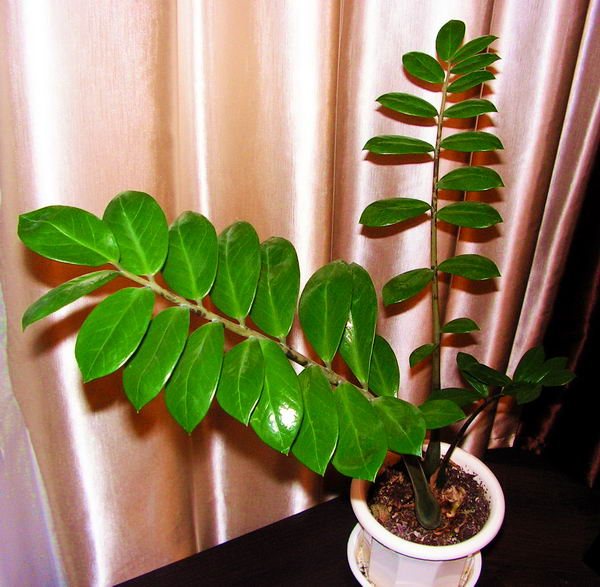
Zamioculcas
To the quality of the soil, the dollar tree does not impose any requirements in terms of its nutritional value, but it should not be heavy - clayey. The plant responds extremely negatively to stagnant water, so it should be planted in light, loose soils, based on sand. A ready-made mixture from the store is not bad - for a cactus. To improve the removal of excess moisture, it is advisable to arrange a drainage layer in the flowerpot, pouring a layer of expanded clay, pebbles or screening out the middle fraction on its bottom.
In terms of nutrients, the plant grows quite normally in poor soil, but if you feed it occasionally, it will only benefit it. However, this should be done exclusively during the active growing season and very carefully. Fertilizers are well suited for cacti, which need to be applied in small portions and no more than once a month. During the dormant period, it is impossible to make top dressing, otherwise the tree will be exhausted by the next season and will hurt. Watering for this time also needs to be minimized.
It is only necessary to transplant zamiokulkas if necessary, replace the flowerpot with a larger one - when the plant becomes cramped, or rather its root system. In order for the plant to take root well after transplanting, its tubers should not be completely buried, their surface must be open.
To summarize briefly, for the normal development of zamiokulkas you need a lot of natural bright light, warmth and limited watering, especially in winter. During this period, it is watered no more than a couple of times a month, otherwise, there is a high probability of infection with various putrefactive infections and the appearance of pests, most often it is aphids.
Consider a number of problems that are most often encountered when keeping and breeding zamioculcas at home.
Houseplants Directory
The trunk of the zamiokulkas has softened and wrinkled. Read in today's article why the trunk of zamiokulkas wrinkled, leaves fade, spots appear? We will show you what to do to restore the zamioculcas. Why did the trunk of the zamioculcas wrinkle?
Shriveled stem, leaves Zamioculcas do not appear spontaneously - plant degradation is preceded by other visible symptoms, for example, falling leaves, yellowing, wilting of the plant. Why do zamiokulkas leaves turn yellow and dry we have examined with you, let's find the reasons why the trunk of the zamiokulkas wrinkled.
What the florists say:
Concept
Zamioculcas flower is an evergreen plant native to South America. It has been known for a long time, but it gained popularity after new species began to appear. The flower is often found in homes because it has many benefits. It does not require careful maintenance, it tolerates drought well, and is calm about light. The plant has an exotic look and grows quickly.
Poisonous zamioculcas belongs to succulents, has a fleshy trunk and thickened leaves to retain moisture. The specific waxy coating helps to avoid strong evaporation and sunburn.
Like the article: "List of poisonous medicinal plants«.
Does zamioculcas bloom? This does not happen often. The flowers are a white ear covered with a green shell. In nature, pollination occurs with the help of wind and small insects. The roots are similar to tubers, retaining moisture for zamiokulkas.
How to save zamioculcas?
- Flooded zamioculcas - dry... Stop watering until the earthy clod is completely dry. Start adding water little by little, slowly moistening or increasing the moisture concentration. Monitor the state of the zamiokulkas.
- Overdried zamioculcas - gradually moisturize... Shriveled from lack of moisture, if it really is, the leaves of zamiokulkas will return to normal as soon as water comes in. It is important not to pour over the tuber with root shoots at a time. In addition, it is imperative to use settled, warm water; do not direct a stream of water at the root collar.
Zamioculcas with rotten tuber due to temperature fluctuations, violations of the same irrigation regime, direct and concentrated fertilizers cannot be saved. It is imperative to remove the zamioculcas from the ground, examine the roots and, if there is something to save, transplant it into fresh ground after pruning and processing. In detail: how to save zamioculcas if the tuber is rotten?
What you need to trim the roots: pruning shears, charcoal in powder, or "Fundazol", as well as fresh earth soaked in 1% solution of potassium permanganate. How to properly transplant zamioculcas?
Adjust lighting - bring zamioculcas back to life
Lack of sunlight has a bad effect on zamiokulkas - the leaves wrinkle due to a short, poor lighting. Direct rays are also not the best helpers in caring for zamiokulkas.
How to highlight zamiokulkas correctly:
- Increase lighting if shaded.
- Do not place in direct sunlight.
- Heat is not lighting.
- Put on the southeast, southwest window.
Where does Zamioculcas usually stand? In the corner on the floor, by the couch or bedside table. The place was chosen for the florist, but not for the zamiokulkas. In such a place, the plant gets sick, gets cold, suffers from a lack of light. It is correct to put the zamioculcas at home on a stand or a high bedside table, not far from the window, or in a well-lit area.
Every time before changing the procedural mode take a close look at the plant: what is missing, what it looks like, what is better to add to the ground, or, conversely, what to exclude from the leaving schedule. The plant is alive, does not live by calendar moisture, feeding, and the vector of development changes depending on the microclimate and season. Zamioculcas: signs and superstitions... Listen to your zamiokulkas, and he will tell you, why did the barrel wrinkleand our recommendations will help you quickly correlate a problem with a solution.
↓ Write in the comments why your zamiokulkas trunk wrinkled? What helped the plant?
Please rate the material you have read :)
First aid for poisoning
If poisonous juice gets into the stomach, you need to urgently call an ambulance, and while it is on the way to rinse.
An adult can drink a solution of potassium permanganate and induce vomiting. The volume of liquid is selected individually - one needs 300 ml, while the other will need 1 liter or more.
After profuse vomiting, you need to drink Smecta or activated charcoal and go to bed. The absorbent will prevent further absorption of the poison into the bloodstream, and the condition will gradually improve.
Toxins are eliminated from the body in fluids, so try to drink water as often as possible.
If a child is poisoned with zamioculcas poison, it is better to take him to the clinic immediately. This is especially true for children under 5 years old.
It is forbidden to wash their stomachs on their own! You can only aggravate a serious condition.
Further intoxication will also require the professional actions of doctors to relieve it competently and without consequences.
Pest infestation
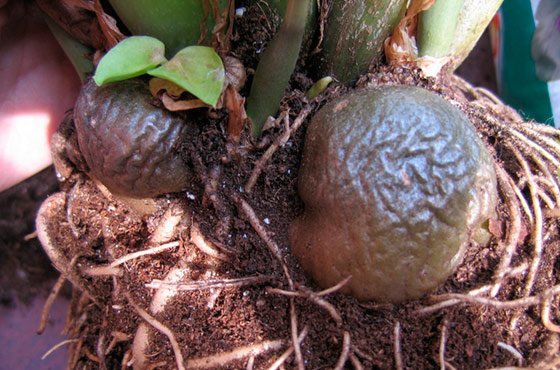

You should not sweep aside the risk of infection with various pests - aphids, scale insects, ticks, etc. Here are the signs by which this can be determined:
- aphids cause wilting and twisting of leaf plates. If you see droplets of sticky secretions, then this is definitely it. First of all, wash the plant with soapy water, and then use any fungicide - "Akarin", "Aktaru" or "Karbofos". Some are struggling with the problem with folk remedies. Aphids are afraid of strong odors and tobacco, garlic, onions, etc. can help you get rid of it.
- dark brown spots on the leaves in the form of outgrowths may be nothing more than a scabbard. Use some kind of insecticide after cleaning with soapy water;
- thin cobweb threads indicate spider mite activity. What to do in this case? From time to time give him a soapy bath, apply insecticides and put under an ultraviolet lamp.
He who is warned is armed, and now you are armed with knowledge and will not let your pet go to waste. See you soon!
Slow and defective development
If the plant begins to lose weight and stretch, the foliage turns pale and reduces the number of lobules on the young, then most likely the reason is insufficient lighting. It is necessary to reconsider the conditions of detention and put the flowerpot closer to the sun, and if this is not possible, it is worthwhile to artificially illuminate the tree. You need to purchase a special lamp for plants that emits a spectrum as close as possible to the sun. Ordinary household lamps will not give an effect - they will not work.
Zamioculcas, in general, and so does not differ in rapid growth, and if it slows down even more, look for the reason in the lack of space for roots - it may be necessary to transplant the plant into a larger flowerpot. Another reason for this behavior is micronutrient deficiencies. Try complex formulas containing potassium, magnesium and nitrogen. The tree reacts especially sharply to a lack of nitrogen.
Why do the stems of zamioculcas go down and what to do in this case?
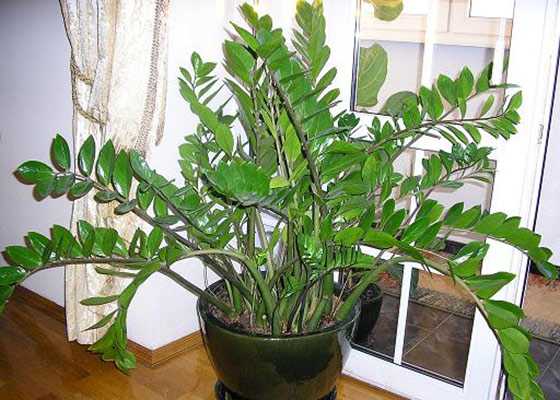

Hello dear readers of my blog! This guest from Tropical Africa flaunts on the windowsills of many residents of the middle lane, delighting with its luscious greenery. However, despite its unpretentiousness, non-compliance with certain conditions of detention is fraught with the emergence of various problems. Today I want to figure out with you why the stems of the zamiokulkas drop?
Daily care tips
The dollar tree is quite resistant to pests and various diseases, provided that it is healthy. If, however, it was not possible to avoid infection, today there are many tools that allow you to quickly solve the problem and cure the plant. After each insecticidal treatment, the ground in the flowerpot must be protected by covering it with a film.
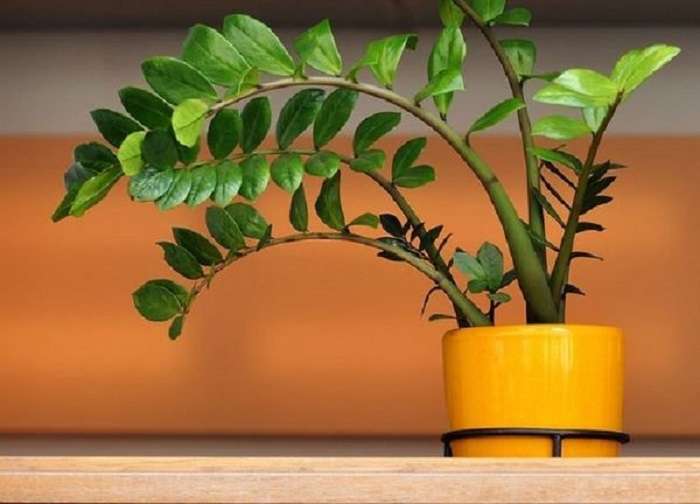

When rinsing chemicals from the plant, care must be taken to ensure that no substances get onto the root system. It is also necessary to equip a good drainage system to remove excess moisture, ensure the correct temperature range and light regime. Under such conditions, the plant will delight you with a beautiful and healthy look all year round.
Fatal outcome


Plant sap can cause irreparable harm to the body.
If the poison enters the body of a small child with allergies, or a person with an acute individual reaction becomes a victim of the toxin, a lethal outcome is possible.
It all depends on the volume of the substance that has entered the stomach. It is hardly possible to die from one or two leaves.
Important! The risk of death is excluded only with timely action to remove the poison from the body. If nothing is done, then even a small dose of the toxin can cause serious harm. Internal organs, especially the kidneys and liver, can be permanently damaged.
Why zamioculcas fell ill, and how to help your beloved plant
Zamioculcas needs adequate care. Zamiocúlcas, a celibate flower or dollar tree, belongs to a monotypic genus of plants from the Araceae family. The homeland of the plant is tropical Africa, and when cultivated on the territory of our country, flower growers may encounter problems such as zamiokulkas dried out, and also does not give new shoots or does not grow and slowly dies. That is why, when growing an ornamental crop, it is very important to do timely prevention of diseases, as well as observe agricultural techniques.
Botanical characteristic
The herbaceous plant has a thick tuberous rhizome and glossy, dark green, complex-pinnate foliage. The average length of the leaves reaches a meter. The leaves are swollen at the base. Less than ten years ago, breeders obtained a miniature cultivar of the plant, represented by a compact bush no more than 0.6 m high, with small foliage.
Zamioculcas are unpretentious plants and easily tolerate low air humidity, as well as partial shading. However, for full growth and development, the plant needs bright rooms and the absence of direct sunlight. An ornamental culture does not react well to excessive soil moisture and moisture stagnation, therefore, irrigation measures must be strictly normalized. If the houseplant is heavily flooded, it means that it will not be possible to easily save the ornamental culture, and it will be necessary to carry out a whole range of restorative measures.
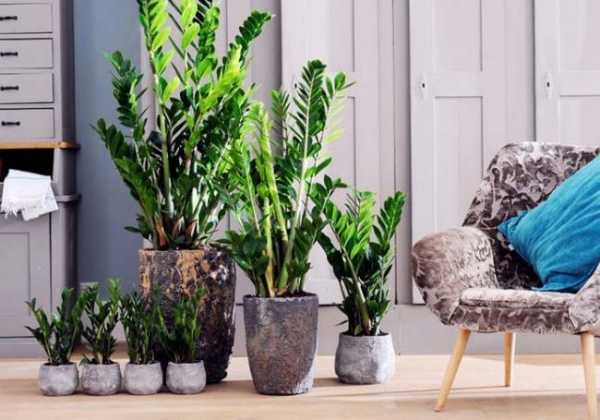

Zamioculcas are unpretentious plants and easily tolerate low air humidity.
How does a plant affect animals
On cats
Cats have a constant need for fresh greens. Many make up for it by gnawing indoor flowers. Toxic juice, getting into the stomach of the animal, causes severe poisoning.
An attentive owner will immediately notice that something is wrong with the pet. The cat screams, lies down on its front paws, vomits, foam comes out of the mouth.
The further outcome depends on the dose received. In any case, she needs to be urgently taken to the veterinarian for gastric lavage.
Important! The degree of intoxication directly depends on the time that will pass from the moment of poisoning. Washing and adsorbents received by the animal in the first hour will save his life. Otherwise, death is possible.
On dogs
Dogs do not feel the need to eat greenery in the house, but they are by nature playful. This is especially true for small puppies - they gnaw everything that catches their eye.
Zamiokulkas leaves can attract a furry mischievous person, he will begin to bite and pull them, so poisonous substances will enter the mouth and stomach.
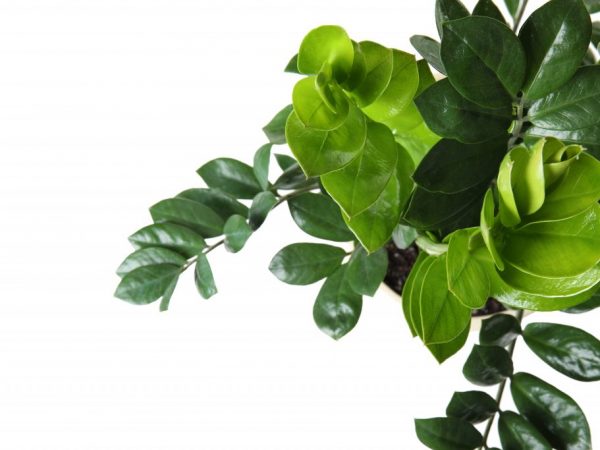

Place flowers out of the reach of animals
Symptoms of poisoning are the same as in cats - pain, vomiting, foam at the mouth, tremors. The animal needs the help of a veterinarian immediately.
You can avoid problems if you put a flowerpot with a flower higher, where the pet will not jump. With a cat, this "trick" will not work, but for a dog it will be enough.
On the birds
Cases of poisoning of parrots with zamioculcas poison have been recorded. These curious birds sometimes peck at plants - out of interest or out of boredom.
The danger is that it is impossible to flush the toxin out of their stomach - washing will kill the bird sooner than the poison itself. They have a completely different digestive system and no bladder, so you will have to save the parrot differently.
At the first symptoms of poisoning:
- With a syringe without a needle, an adsorbent diluted in water is poured into the beak - activated carbon, Enterosgel, Karbolen, Sorbeks.
- An hour later, you need to give a laxative - a decoction of flax seeds, or Glauber's salt. When vomiting, 1 drop of Cerucal is dripped into the beak of the parrot.
- Further, you only need a plentiful drink.
If the dose of the toxin is low, the bird is likely to recover.
Zamioculcas - dollar tree
The popular name for zamiokulkas is a dollar tree, I learned about this quite recently. Last year I chose a flower for my friend's birthday. I tried to take into account the peculiarities of her apartment.
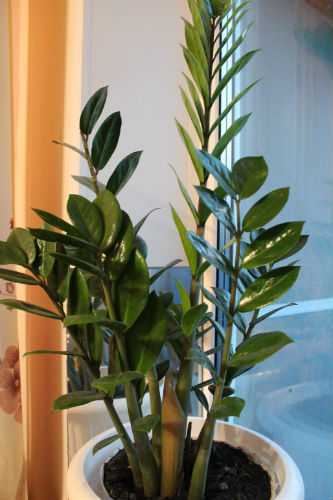

The seller advised me to take a dollar tree. I was at a loss and asked to clarify what it was, they showed me to zamioculcas. This plant had already been in the store for several months, and since it was January, this fact played a decisive role (it was a cold winter and the flowers could be damaged during transportation).
At home, I noticed that the zamiokulkas seemed to "jump out" from the pot. The seller advised him to transplant. I chose a slightly larger pot. When transplanting, the plant was divided into several pieces. As a result, one part remained with me. Later she regretted that she had started a transplant during the cold period.
The plant, which she gave to her friend, has partially disappeared - some of the cuttings have rotted. After a while, the share that remained with me also rotted away. So much for dubious guarantees - staying in the store for several months. Everything was decided by the untimely transplant.
Almost a year has passed. Recently I noticed that my friend had two dollar trees. The second was given to her by a scion. It was summer, and it got accustomed well.
Zamioculcas belongs to the aroid family - these are the well-known dieffenbachia, philodendrons, monstera, etc. Over the past ten years, zamioculcas has become widespread among florists.
It ceased to be exotic and, accordingly, began to be in less demand. There is no chic and beauty in his appearance, so I always postponed the purchase until later. And after I bought it for a gift, I completely lost interest.
But a friend gave me a leaf from zamiokulkas (accidentally broke). The leaf was at least 30 cm long, with a thick petiole and juicy leaves. She cut off the top, separated several lower leaves, and began to root. I placed a large leaf in a vase with slightly damp vermiculite.
The rest of the parts are also rooted in vermiculite, but in a closed container. All parts took root in a month and a half. But the smaller ones - the top of the leaf and the leaves quickly fell into a dormant period, i.e. their leaves turned yellow. I found several nodules 1 cm in diameter in vermiculite. The large leaf took longer to take root.
I planted it in a tall, narrow pot with good drainage. It was a warm period. I rarely watered. I also planted nodules, but in a small pot. They never germinated.
The large leaf did not grow at all in the first year. Stood and stood. Then something incomprehensible appeared at the base. It even seemed to me that it was a bud, but a leaf appeared, only of a small size. His leaves were also small. During the spring-summer period, the zamioculcas gave three more large leaves, and the first one remained juvenile.
Zamiokulkas stood on the kitchen window. He did not suffer from the heat. Closer to winter, I had to move it to the other, darker, side of the window sill. This immediately affected the color of the new leaf - it grew light green.
I don't know if the color will change in the summer. I noticed that in many institutions, zamioculcas are placed quite far from the windows, from this they stretch out and the "bush" falls apart.
Signs associated with zamiokulkas
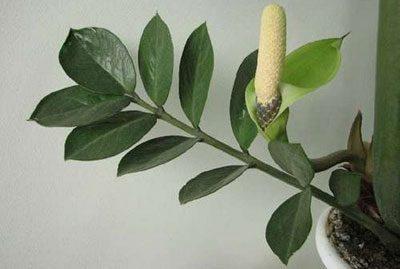

Many people know Zamioculcas under the interesting name "Women's happiness". As the popular rumor has it, it is this flower that somehow magically contributes to female happiness. But in order for this magical property to manifest itself in full, certain conditions must be met:
- The flower must be presented.
- Magical properties appear only during the flowering period of the flower, and it blooms oh, how rare.
If you believe all the same you will accept, as soon as this succulent blooms, happiness will immediately knock on the house, and not anyhow, but feminine.
Another name for the flower is the dollar tree. According to the teachings of Feng Shui, this flower is able to attract financial well-being to the house, like a fat woman.... But if in the latter, to attract money, you need to bury coins in a pot, then zamiokulkas just need to settle in your house.
Zamioculcas benefit. Is it possible to keep zamiokulkas at home, gardeners recommend


Plants were created not only for the enjoyment of humans, but also for peace of mind and human well-being. Decorated with beautiful and delicate flowers, the windows in the house change its entire appearance and create coziness in it. How dull the world would be without flowers! Can zamioculcas be kept at home? Questions are asked by many lovers of exotic flowers.
The green color of the plant world can improve a person's mood, as well as his performance.
Juicy green leaves of zamiokulkas will contribute to your good state of mind even on gray and cloudy days. This bush will brightly illuminate an ordinary weekday, raise a depressed state of mind, and also delight the patient.
Is it possible to keep zamioculcas at home pluses
Zamioculcas perfectly cleans the air. After all, everyone knows that indoor plants reduce the level of carbon dioxide by converting it into oxygen. And in order for the flowers to be of the greatest benefit, they need to be placed where you usually sleep or rest. Then your dream will become serenely sweet and soothing. And in the morning you will feel cheerful and cheerful. Zamioculcas can also be placed in the room in which your child does homework. By improving air quality, he will increase his attention, efficiency, which, in turn, will lead to good school performance.


By the way, doctors noticed that patients recover faster if there are indoor flowers in their ward. Recent studies have shown that patients who were in the ward with plants suffered much less pain. They also liked the conditions in which they were kept more than patients from other wards. Zamioculcas can be placed in a room where a patient is lying, for example, suffering from chronic diseases. This will give him vigor and help him become more cheerful. And since zamioculcas rarely releases its flower, it will not emit a harsh and strong floral scent, which is ideal for those who are highly susceptible to odors. Also, it will not cause an allergic reaction, so you can safely give it to a friend who is hypersensitive to allergens.
Actually, it would be very nice if everyone had their own green corner. Indoor flowers could be a bright decoration for your home. Well, a properly selected flower will not only delight your eyes, but will also help to recuperate at the end of a hard day.
Zamioculcas is poisonous or not
It is impossible to call a plant poisonous in the literal sense of the word, in itself it does not pose any danger to the health and life of people. However, if the trunk and branches are mechanically damaged (for example, during pruning, transplanting or reproduction), milky sap begins to emerge from the place of the "scar". It is irritating to human skin and mucous membranes. The most typical symptoms of a lesion are:
- Tingling sensation;
- Redness;
- Itching;
- Burning.
These symptoms usually disappear quickly after the contact between the skin and the flower has ceased. However, in children and adults prone to allergies, contact with the poisonous sap of the plant can cause eczema or hives; in severe cases, Quincke's edema may occur, requiring immediate medical attention.
Poisonous juice is especially dangerous for children under three years old. However, there is a plus in the poisonousness of the flower: zamiokulkas is very rarely affected by pests and parasites. To minimize the release of poisonous juice during pruning, the procedure must be carried out with sharply sharpened scissors or a special pruner. Fresh cuts must be sprinkled with powdered charcoal, so they will tighten faster and no harmful juice will be released.
Attention! In contact with the eyes, the poisonous sap of the dollar tree can cause severe burns to the mucous membrane, as well as profuse lacrimation and redness of the eyelids. If such a nuisance still occurs, you need to urgently rinse your eyes with clean water and in no case rub them, so as not to aggravate the situation.
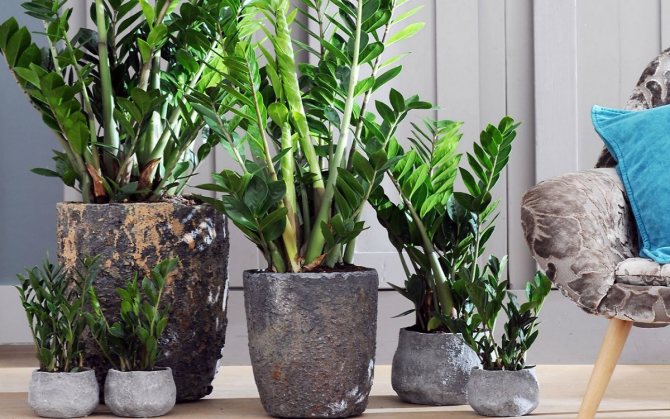

Zamioculcas juice can cause burns
Zamioculcas | Zamioculcas (Dollar Tree) - Flowerpot Zone


Aroid family. Homeland about. Madagascar. Zamiaculcas is an evergreen tuberous plant with dark green fleshy leaves, pointed at the end. The surface of the sheet is glossy. The stems are thick, the leaves sit on them symmetrically, alternately. The plant is large, grows in an apartment to a height of about 1-1.5 meters. It blooms in indoor conditions, if it is provided with appropriate conditions of detention with white flowers, but at a fairly old age. Undemanding in culture.
Temperature: Moderate, preferably 16-18 ° C in winter, but not below 12 ° C.
Lighting: Bright place with diffused light. In summer, he prefers outdoor accommodation - on the balcony, in the garden, etc. In winter, you will have to rearrange the zamiokulkas closer to the window.
Watering: Moderate from spring to autumn, but at the same time no water should remain on the pallet, in winter watering is rare, the soil should dry out well before the next watering. Zamioculcas tolerates some overdrying more easily than stagnant water in the soil - this can lead to root rot and the formation of stem rot.
Fertilization: From April to August, fertilizing is carried out every two weeks, since the zamioculcas quickly consumes nutrients. You can use fertilizers for cacti and succulents.
Air humidity: Zamioculcas does not require spraying the leaves, but sometimes it is necessary to arrange washing so that the plant does not become dusty and does not lose its attractiveness. In summer, rain showers are sufficient in the open air.
Transfer: Annually in the spring. The soil should be fairly nutritious. For young plants - 1 part of sod land, 1 part of leafy land, 1 part of peat and 1 part of sand. You can add a little well-rotted humus earth. Transplantation of old copies of zamiokulkas is carried out every two years in the spring. The pot for zamiokulkas should be commensurate with the root system. Good drainage is a must.
Truth or myth: all about the toxicity of a home plant
An apartment without indoor flowers looks boring. She seems to be deprived of life. In addition to the interior function, such decorative elements, being living representatives of the flora, are designed to purify the air through photosynthesis, thereby helping a person feel more comfortable.It is noted that some of the domestic plants have a psychological effect on the owners, stabilizing their psychosomatic state.
Many color lovers would like to see zamiokulkas in their home. Is this representative of indoor plants poisonous or not and how can such a neighborhood affect human health?
65% of decorative flowers and flowerpots contain toxic substances in their juice that pose a potential threat to the health of an adult, a child, and pets.
Almost all members of the Araceae (Aroid) family, including zamioculcas, are harmful. The houseplants you know belong to this large genus: spathiphyllum, dieffenbachia, scindapsus, philodendron, epipremnum and many others.
Let's figure out together whether zamiokulkas is poisonous or not for any living creatures.
Toxic sap circulates in all parts of the exotic plant. Don't panic and don't rush to get rid of your pet. Do not be afraid to touch the leaves of the dollar tree or other parts of it.
The question "is zamioculcas poisonous or not?" causes controversy.
As a result of the study, 10 out of 10 surveyed color lovers say that growing such a plant at home did not bring them any discomfort. There was no deterioration in the state of health, which means that the growing dollar tree with its presence did not wag the owners in any way: allergic reactions did not appear, and cases of burns of the skin of the hands with careful handling of the flower were not recorded.
Do not forget that the sap of the plant is poisonous, therefore, if you damage it, be careful with it. The flower itself does not emit toxic fumes that could cause intoxication in a living organism.
But! Since zamioculcas is poisonous, it means that it is potentially dangerous.
Care Tips
In order for zamioculcas to please its owners with beauty, it is worth paying due attention to it and adhering to the appropriate care rules. Upon completion of the treatment of the plant with insecticides, it is worth protecting the soil by covering it with a film. In a day, when the chemicals are washed off with water, the flower must be protected from their penetration to the root. For this, the substrate is re-covered.
The main thing that should not be forgotten is that the "dollar tree" is a representative of the flora, resistant to infectious diseases, but only under the condition of absolute health. An exotic flower should be provided with fluid drainage, the correct temperature and lighting regime.
In the summer, zamioculcas needs to be taken out into the street, this will make it stronger and more beautiful.
The following video will tell you how to treat zamioculcas.
Zamioculcas (dollar tree) is an exotic decorative flower that has taken root well in indoor conditions due to its unpretentiousness. It pleases with good growth in both dry and humid air, does not need frequent watering and easily tolerates dry soil. However, the tree, like other indoor plants, is vulnerable to various diseases and pests. Therefore, in this article we will consider the features of zamioculcas diseases, how they proceed, the main symptoms and methods of treatment.
Stem decay
Decay of the stem of the zamiokulkas signals a serious illness, since often root rot develops at the same time. The main reason is excessive watering and low temperatures in combination with improperly prepared soil. If the soil is heavy, clayey, in cold weather it is not able to drain even a limited amount of water, and this leads to its stagnation and, as a result, rot on the plant.
In such a situation, the first step is to normalize the external conditions - temperature and watering, and then, you will have to remove the plant from the flowerpot and heal. All its parts are treated with a solution of fungicides and planted in a new flowerpot or disinfected the old one.The old land will have to be thrown away and replaced with a new one.


In the case when it is impossible to save a dollar tree - its tubers are severely affected, it will have to be disposed of, but a new plant can be grown from its upper part by rooting part of the leaves.
Zamioculcas turned yellow:
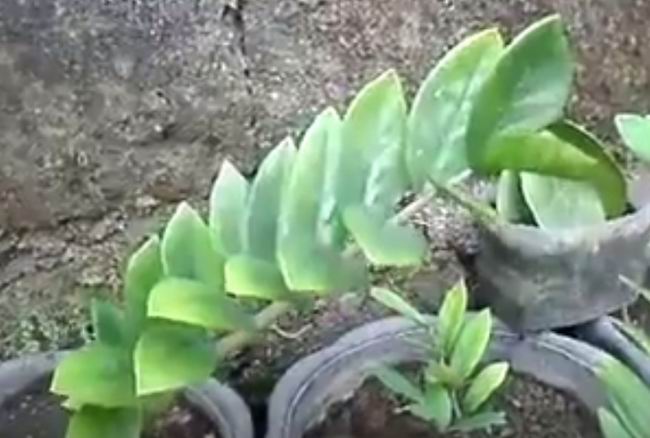

When the leaves turn yellow, does the plant still give young shoots? This means that everything is in order. This is a natural biological renewal process. Young leaves, possessing greater activity, take away all the necessary nutrients from the soil, leaving almost nothing for the more mature leaves. In this case, you should pay attention to the presence of dark spots on the leaves. Dry spots don't give you any reason to worry, the plant is fine. It does not require any additional care or external intervention. But, frequent and abundant watering can lead to yellowing of the plant. Reducing fluid volume may not always be the solution. Often you have to take the plant out of the pot to examine it for decaying areas of the root system. They are removed by sprinkling the cut areas with crushed coal, treated with special substances that prevent the development of rot and transplanted into a new substrate.
Zamiokulkas tolerates a change in the temperature regime in the room very badly.
The plant can react to this with yellowed and falling leaves. Indoor species are more thermophilic than their wild relatives. They can react to absolutely any fluctuations, whether it be the wind blowing from an open window, a running fan or any heating device. In winter, when the room temperature rises, it is recommended to humidify the air.
Poison flower and children
Zamioculcas is especially dangerous for young children. Due to their natural curiosity, babies often pull into their mouths everything that comes their way. Sometimes this leads to severe poisoning.


If the swallowed parts of the plant can only cause digestive upset in adults, then after chewing on a leaf, the child may end up in the intensive care unit. This is due to the fact that the immune system of children is not yet fully formed, as well as the digestive organs do not yet have enough enzymes to neutralize toxic substances.
Flowers in zamiokulkas appear at an already advanced age of the plant and although they are ugly, they are very attractive to children. When parts of a plant get inside, children may have the following disorders:
- excruciating nausea and profuse vomiting;
- high fever and cramps;
- loose stools.
In severe cases, there may be confusion and hallucinations... Children usually have a hard time tolerating any intoxication, therefore, treatment must be carried out in a hospital setting.
When pollen gets into the eyes, the mucous membrane becomes inflamed, which is manifested by a deterioration in vision. If you do not provide assistance in time, there may be a serious burn of the mucous membrane and a persistent deterioration in the child's eyesight.
The doctor must be shown the parts of the plant that the child accidentally consumed. This will facilitate diagnosis and treatment.
Zamioculcas - diseases caused by pests
Healthy sprouts of zamiokulkas, not infected with the scabbard
The leaves of the zamiokulkas are quite dense, and the trunk and stems are strong, therefore, damage to the plant by pests usually occurs when its protective qualities are weakened.
The reason for the deterioration of the tree is more often the improper care of the plant.
A sign of a spider mite affection of a tree is the appearance of a thin, slightly noticeable snow-white cobweb in the interstitial region.
The cobweb contributes to the appearance of lethargy and dryness of the leaves, and if the cause of the lesion is not identified in time, the tree may die.
To get rid of the tick, the plant is wiped with a damp sponge, which is moistened in an aqueous solution of laundry soap.Then the plant is sprayed with infusion with tobacco and after half an hour the leaves and stems are washed with warm water.
Expert opinion
Yulia Yurievna
I have a large garden and vegetable garden, several greenhouses. I love modern methods of plant cultivation and soil mulching, I share my experience.
Ask a Question
Spider mites are one of the most dangerous pests. It is quite difficult to get rid of it, because the larvae of this pest are almost not damaged by drugs.
For this reason, processing can be started with preparations that sterilize female ticks. An effective remedy for such a pest is Neoron. But, even they need to carry out several treatments. Also, it is important to increase the humidity in the room where the zamiokulkas is located. Dry and warm air promotes intensive reproduction of mites. The infected plant must be isolated.
Just like with a spider mite, they fight against damage to the plant with a scabbard. These pests multiply very quickly, so you need to start fighting them as soon as you notice a problem.
If the plant is often taken to the balcony, its leaves may become damaged by aphids. With such lesions, small black dots appear on the leaves of the tree, contributing to the curling of the leaves and their loss of a rich emerald color.
In the absence of action to combat harmful insects, the leaves begin to turn yellow and fall off, which leads to the premature death of the plant. Fitoverm is used to combat aphids. Preventive agent against aphids "Actellik" or "Intavir".
Drying leaves
With rare exceptions, this process is quite natural - first, the lower leaves of the flower die off, then they turn yellow and fall off the trunk. If there is a fall of young, just appeared leaves, look for the reason in violation of the rules of care. They are typical - low temperatures, drafts and stagnant water in the flowerpot.
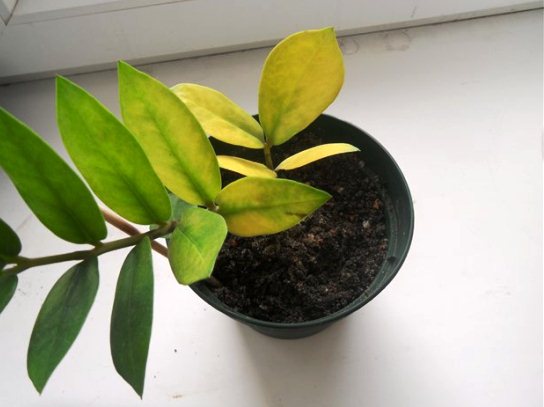

The fall of young leaves is a wake-up call. To prevent the development of a disease, it is better to immediately transplant the plant into a new flowerpot, until the rot has killed it.
Zamioculcas what to do if the tuber has rotted:
The reason for this condition is again excessive watering of the plant. He needs to be transplanted urgently. Transplant soil must be purchased at a specialized store; ordinary soil from the street will not help restore the plant. These store-bought substrates are rich in all the micronutrients necessary for quick plant recovery. A sharp knife will help to cut off all the rotten elements of the rhizome, the remaining healthy part in the places of the cuts is treated with special solutions. Only then is the plant ready for transplanting. For 24 hours after transplantation, the zamiokulkas should stand in peace and quiet. No fertilizers or other means are allowed. After the time has passed, you can begin to water gently. Organic fertilizers will be useful in a week, you must continue to apply them for 1 month no more than 1 time per week.
How to prevent poisoning
The cultivation of a poisonous plant requires compliance with safety rules. This will help protect loved ones and animals from poisoning.
Prevention:
- Transplanting the plant, cutting off the leaves and stems is required with gloves;
- After working with zamiokulkas, hands are thoroughly cleaned;
- The pot is located in places that are difficult to reach for children and pets;
- If there are people with allergies in the family, it is recommended to refuse the flower.
It is better to remove inflorescences from zamioculcas to avoid allergic reactions. Compliance with simple prevention will help avoid unpleasant consequences.
The appearance of spots on the leaves and trunk
Why do dark and black spots appear on the stems and leaves of zamiokulkas? Dark spots on the trunk of the zamiokulkas indicate that the flower is in unfavorable conditions.
As a rule, darkened areas on the leaves indicate violations of temperature regimes or excessive watering of the plant.
To get rid of blackouts, it is necessary to increase the temperature in the room where the plant is located and take care of protecting the tree from unnecessary drafts.
As for watering, they need to be limited. It is also important to ensure that there is a good drainage layer. If this layer is unreliable, it is best to transplant the plant into a new flower pot.
Sometimes darkening on the leaves can appear from the burn of the plant by the sun's rays. Zamioculcas can get sunburn when exposed to direct rays after spraying. Water droplets on leaves increase the influence of sunlight and promote staining.
As for the spots that appeared on the trunk, they do not indicate any disease. Spots and stripes can be on the trunk with absolutely normal development of the tree.
The main thing is that there are no signs of rotting processes and damage to the plant by pests that have a negative impact on its development and growth.
Diseases and problems
When caring for zamiokulkas, always remember that it is a succulent that collects water and stores it in the tubers and fleshy parts. Therefore, be zealous in watering Absolutely forbidden... Most of the diseases of the Zamioculcas (dollar tree) are associated with an excess of water.
Zamioculcas turns yellow
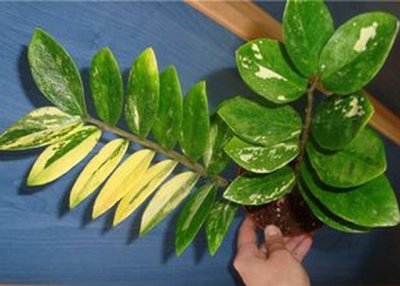

Below is the answer to the question why the leaves of Zamioculcas (dollar tree) turn yellow and what to do if they turn yellow at home. The reasons for the yellowing of the dollar tree can be different. Green leaves may change color due to natural aging... In this case, only the lower ones turn yellow and fall off and in single copies. At the same time, young leaves are formed on the tops of the branches.
Mass yellowing of Zamioculcas leaves of any age is caused by sharp jumps temperature and a stream of cold air. Check if the plant is standing in a draft.
If only the tips of the leaves turn yellow, then the room is too arid the air that the dollar tree suffers from.
Yellowness on young leaves is evidence improper watering... Excess moisture provoked rotting of tubers and roots.
If all the leaves at once turned yellow and fell off, then you overdid it, not watering the plant at all. Zamioculcas decided that a summer drought had come and prepared for it. In this case, his need to transplant into fresh soil and start regular watering... Young twigs will soon come from old stems.
If not growing
The answer why Zamioculcas or the dollar tree grows poorly and does not give new shoots at home is presented below. A young bush generally grows very slowly, giving no more than a couple of leaves per year. This is because the flower of celibacy throws all its strength for tuber development and adjacent roots.
He begins to grow the ground part only after he has mastered the entire surrounding space in the pot.
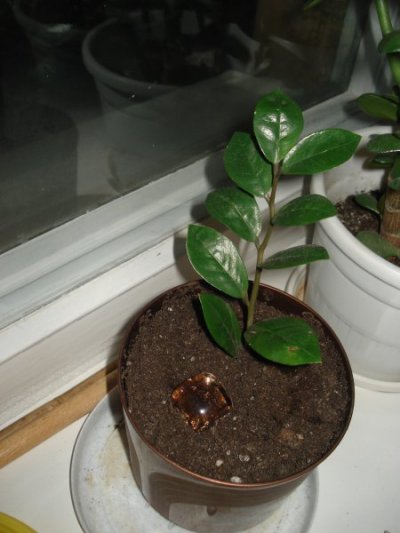

The same thing happens if you plant even a completely adult plant in a spacious container.
Another reason for poor growth and lack of new shoots is destruction of the root system... If the flower is often watered or the water is not provided in the pan, the tubers will most likely rot.
Naturally, development completely stops, and the zamioculcas dies. All that can be done in this case is to cut off the ground parts and try to root them again.
A dollar tree can rest, stopping growth for a dormant period. Since the plant came from Africa, its "hibernation" begins in February and lasts until July.
Dark spots
What do the dark spots on the Zamioculcas trunk indicate? The appearance of black and dark brown spots on the leaves and stems of the dollar tree signals perfect care gaps.
Blots can form from keeping in a cold room, decay of individual roots and tubers, during overflow.
Stains on the trunk can also indicate excessive soil moisture. In addition, they appear if some of the roots die off for any reason. If there are no other problems, and the tree is developing well, then this is just a natural decoration of the zamiokulkas.
The stem is shriveled
Why did Zamioculcas have a shriveled stem? This can only come from a serious lack of water... The plant tries to use its reserves and is gradually depleted.
Either you very rarely water the zamiokulkas, or you use an insufficient amount of water, or the lump of earth has hardened and the water flows into the pan on the sides, without soaking the soil.
Tubers and roots rot
What to do if the roots of Zamioculcas rot?
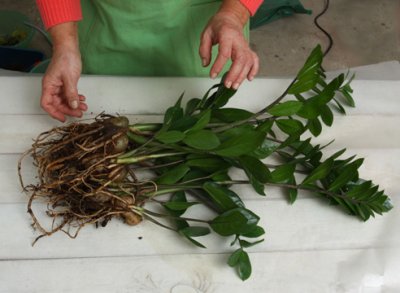

The most common problem that occurs when growing zamiokulkas. She appears from overflow and excess water in the earth.
Constantly moist soil and a warm environment attract pathogenic fungi, which cause rotting.
To save the plant, you will have to act radically. The tree must be removed from the pot, free from the roots of dirt and rinsed in warm water. Now you should cut off all the affected roots and cut out the rotten areas from the tubers. Only healthy tissue should remain.
Then the zamioculcas needs to be processed any systemic fungicide - Hom, Acrobat, Vitaros, Fundazol. The pot and all the soil is replaced with a new one, previously disinfected with boiling water or heating in the microwave. Only after this is the plant planted in a container.
For severe, widespread lesions, when the tubers rot whole, the stem or leaves should be cut off and rooted. You can use exclusively non-infected parts of the flower.
Branch broke off
What to do if a branch of a dollar tree breaks off? If you accidentally break off the escape, don't be discouraged! Sprinkle the wound on the zamioculcas activated or charcoalto prevent bacteria from attacking.
And cut the broken off shoot just above the break and put it in a container with water. Soon, roots will appear on it, and you can get another dollar tree to your collection.
Why is the dollar tree crying?
Thus manifests plant defense mechanism, thanks to which the plant, like other aroids, gets rid of excess water. Zamioculcas cries after too much watering and when the humidity in the atmosphere rises, for example, after spraying or before rain.
Gutting (plant crying) occurs when the surface of the leaves ceases to evaporate moisture or does not have time to get rid of it. At this time, hydatodes are activated - glands located at the tips of the foliage. They throw water droplets out.

